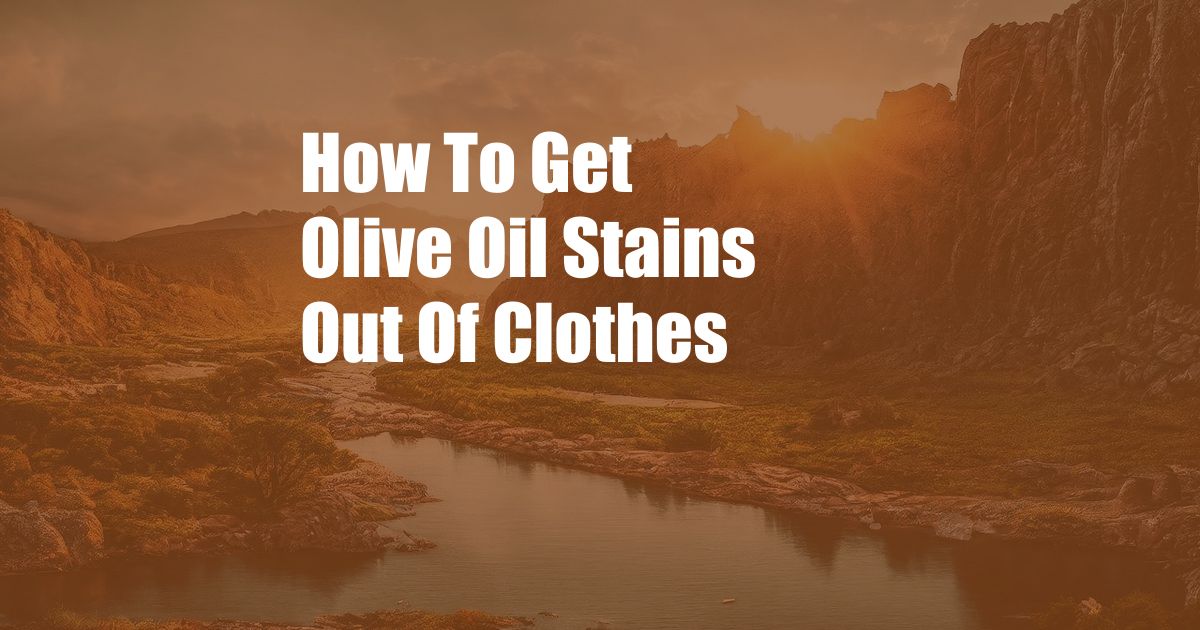
Olive Oil Stains: A Kitchen Nemesis and How to Conquer It
I’ve always been a culinary enthusiast, but my love for cooking has been plagued by a persistent nemesis: olive oil stains. Those stubborn marks can transform a pristine garment into a canvas of culinary disasters. Yet, beneath the surface of these frustrating blemishes lies a fascinating tale.
Olive oil, with its golden hue and velvety texture, has been a kitchen staple for centuries. Its rich history traces back to ancient Greece, where it was revered as a symbol of purity and health. It’s not just a culinary treasure but also a testament to the enduring power of nature’s bounty.
The Science Behind the Stain
Olive oil, composed primarily of triglycerides, has a nonpolar molecular structure. This means it repels water, making it challenging to remove with conventional detergents. The oil’s hydrophobic nature allows it to cling tenaciously to fabric fibers, leaving behind unsightly stains.
The complexity of olive oil stains lies in its ability to penetrate deep into the fabric. As the oil seeps into the fibers, it interacts with the dyes and pigments, causing discoloration. This deep penetration makes it essential to address the stain promptly and effectively.
A Multi-Pronged Approach to Stain Removal
Conquering olive oil stains requires a multi-pronged approach that harnesses the power of various techniques. From DIY remedies to commercial stain removers, there are several options to consider. Let’s delve into each method and explore its effectiveness:
**Baking Soda:** Baking soda, a trusted household staple, acts as an absorbent and neutralizer. Sprinkle it generously on the stain, allowing it to rest for several hours or overnight. Brush off the excess and launder the garment as usual. Baking soda is most effective on fresh stains.
**Cornstarch:** Similar to baking soda, cornstarch absorbs oil and helps lift it from the fabric. Apply a thick layer of cornstarch to the stain and let it sit for at least 30 minutes. Vacuum or brush away the powder and launder the garment.
**Dish Soap:** Dish soap, designed to combat grease and grime, can also be effective in removing olive oil stains. Apply a few drops of dish soap to the stain and gently rub it in. Allow it to sit for 15-20 minutes, then launder the garment as usual.
**Commercial Stain Removers:** Commercial stain removers, specifically formulated to tackle tough stains, can be a potent solution. Follow the manufacturer’s instructions carefully, testing the product on an inconspicuous area first. Apply the stain remover directly to the stain and allow it to work its magic.
**Professional Dry Cleaning:** For particularly stubborn olive oil stains, professional dry cleaning may be the best course of action. Dry cleaners have access to specialized equipment and detergents that can effectively remove deep-seated stains without damaging the garment.
Expert Tips and Advice
Beyond the aforementioned techniques, there are additional tips and expert advice to enhance your stain removal endeavors:
**Act Quickly:** Time is of the essence when dealing with olive oil stains. The longer the stain sits, the deeper it penetrates the fabric, making it more challenging to remove.
**Blot, Don’t Rub:** When addressing a fresh olive oil stain, avoid rubbing it. Blot the stain gently with a clean cloth or paper towel to absorb as much oil as possible. Rubbing can spread the stain and make it more difficult to remove.
**Use Cold Water:** Cold water is less likely to set the stain and spread the oil further. If possible, rinse the stained area with cold water before applying any stain removal techniques.
**Test on an Inconspicuous Area:** Before using any stain removal method, test it on an inconspicuous area of the garment to ensure it doesn’t cause any discoloration or damage.
FAQs on Olive Oil Stains
To further empower you in your battle against olive oil stains, let’s delve into a series of frequently asked questions and their comprehensive answers:
Q: Can I use bleach to remove olive oil stains?
A: No, bleach is not recommended for removing olive oil stains. Bleach can damage the fabric and set the stain, making it more difficult to remove.
Q: Is it possible to remove an olive oil stain that has set for several days?
A: Removing a set-in olive oil stain can be more challenging, but it’s not impossible. Try using a commercial stain remover or consider professional dry cleaning.
Q: What type of fabric is most susceptible to olive oil stains?
A: Delicate fabrics, such as silk and wool, are more prone to staining from olive oil. Synthetic fabrics, like polyester and nylon, are more resistant.
Q: Can I use olive oil as a stain remover for other stains?
A: While olive oil may seem counterintuitive as a stain remover, it can be effective in removing certain types of stains, such as ink and lipstick.
Conclusion
Mastering the art of removing olive oil stains empowers you to safeguard your garments from culinary mishaps. By understanding the science behind the stain and employing the techniques outlined above, you can restore your clothes to their pristine condition.
Remember, the key to success is prompt action and the right approach. Embrace the challenge of olive oil stains with confidence, knowing that you have the knowledge and tools to emerge victorious. Whether you’re an experienced homemaker or a culinary novice, may this guide serve as your trusty ally in your kitchen adventures.
Are you ready to conquer olive oil stains and elevate your culinary prowess? Share your experiences and insights in the comments below.